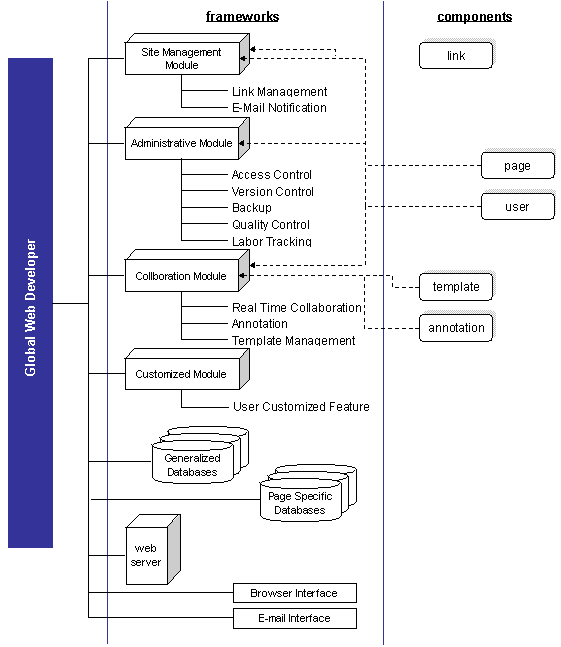 Distributed
Computing Applications and Infrastructure (IS 206)
Distributed
Computing Applications and Infrastructure (IS 206)
Fall 1998
[Group
E Home] | [IS206
Home]
Software Components and Frameworks
[top]
Small-grain software components assembled into the application includes "page",
"user" and "link." These components are general for any
web based application. Components such as "template" and "annotation"
are specific to collaborative authoring applications. All components fit into
the frameworks of the application as shown in the figure
above.
- Page
This component holds information of tags and contents as well as metadata
of each page, such as author, date of creation, traffic etc. "Page"
component is the principal component of any web based application. Examples
of such application include web authoring tools and intranet applications.
- Link
"Link" component is also useful in any web based application. It keeps track
of links between pages and organizes the pages of the site. This component
manages the relationships of the pages under one site while "page"
component deals with pages themselves not their relationships. Since this
component is strongly related to "page" component, its application
area is same as that of "page" component.
- User
This component represents a user of web pages. The user can be an author of
the page or a visitor of the page. It not only identifies a user, but also
keeps information about the user's permission to access particular resources
and control the access to the pages. "User" component can be utilized in any
web based application. It is especially useful in intranet applications which
need to manage a large number of users under one application.
- Template
This component is specific to collaborative feature of the application. It
represents different types of templates and holds information about creator,
date of creation, and usage of each template. It is possible to use "template"
component in other collaborative authoring applications which needs effective
management of templates accessed by multiple users.
- Annotation
As the "template" component, this component is specific to collaborative operations.
It holds content of annotations as well as reference information of each annotation.
This component can be used in collaborative authoring applications or other
applications which support commenting function.
[top]
Modularized architecture of the application is a set of frameworks designed
to support the application's various features. The following modules constitute
the main framework of the GWD.
The components introduced in the previous section fit into these frameworks
as shown in the figure above. Each framework supports
specific features of the application. (click the links above to learn more about
these features.)
It is also possible to introduce a customized framework into the existing application.
GWD's flexible modular architecture enables easy expansion and customization
of the application.
[top]
For a company developing Global Web Developer as its primary product, it makes
sense to focus on the core competencies required for the product. Because providing
web development tools is the fundamental purpose of GWD, some required application
components such as a DBMS are outside the logical scope of the development project.
Here listed are the large-grain available components for which it make good
business sense to incorporate into GWD:
- DBMS
A substantial number of GWD's special features require the use of a robust
DBMS. To deliver the functionality and performance attributes necessary to
make GWD viable, a proven DBMS suited for GWD's requirements must be selected
and incorporated into the application. Inclusion of a standard, scalable DBMS
should adhere to the usual practices consistent with this common process.
For a list of databases required for the application and information managed
by these databases, please refer to the following links:
List of Databases
Database References by Feature
-
Web Server
An obviously key component for GWD is a web server. Not only is this component
required to eventually serve the pages and content produced using GWD, but
it must also be included to support the standard web browser interface for
using GWD itself. Because the web server market is not as mature as the
DBMS market, more care should be taken when integrating the web server component
to protect against reliance upon a specific web server product.
- Browser Interface
GWD employs conventional web browsers as its interfaces. Users can pick up
any browser they perfer.
- E-mail Interface
E-mail is utilized in various features of GWD for notification purpose. (e.g.
Traffic-Based Link Suggestion, Content-Based
Link Suggestion, User E-mail Alert)
As in the case of browsers, any e-mail application can be used with GWD.
[top]
Milestone 4 top
last updated 11/09/98




 Distributed
Computing Applications and Infrastructure (IS 206)
Distributed
Computing Applications and Infrastructure (IS 206)